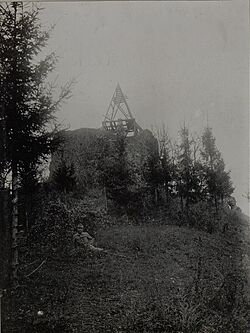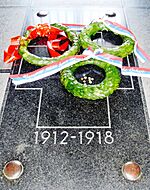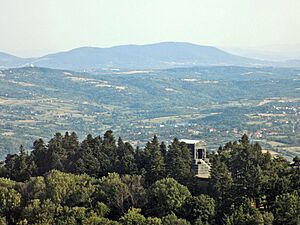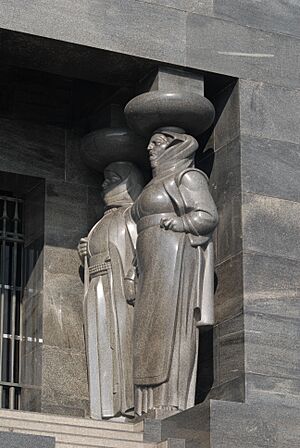Monument to the Unknown Hero facts for kids
Quick facts for kids Monument to the Unknown Hero |
|
|---|---|
| Serbia | |

Monument to the Unknown Hero
|
|
| For Balkan Wars and World War I heroes | |
| Unveiled | 28 June 1938 |
| Location | 44°41′19.3″N 20°30′56.9″E / 44.688694°N 20.515806°E Avala
near |
| Designed by | Ivan Meštrović |
|
Unknowns
|
1 |
|
Alexander I King of Yugoslavia to the Unknown Hero
|
|
|
Cultural Heritage of Serbia
|
|
| Type: | Cultural Monument of Exceptional Importance |
| Designated: | 1984 |
| Reference #: | СК 644 |
The Monument to the Unknown Hero (which in Serbian is called Spomenik Neznanom junaku) is a special memorial. It honors soldiers who fought in World War I. You can find it on top of Mount Avala, a mountain near Belgrade, Serbia. A famous sculptor named Ivan Meštrović designed it.
This monument was built between 1934 and 1938. It stands where an unknown Serbian soldier from World War I was buried. Many countries that were allies in the war built similar "tombs of the unknown soldier" to remember their heroes. Before this monument, an old fortress called Žrnov stood on the same spot.
Contents
How the Idea Started
In October 1915, during World War I, fierce battles took place on Mount Avala. Serbian soldiers bravely defended the mountain from attacks by Austro-Hungarian and German forces. On October 17, the attacking armies took control of Avala. Their soldiers then buried the Serbian fighters who had died.
In a valley below the old Žrnov fortress, they buried one soldier. On his grave, they placed a wooden cross. It had a German message that simply said: "One unknown Serbian soldier." This was the beginning of the idea for a monument.
The First Monument
In the late 1920s, people in Serbia heard about France burying its "unknown soldier." This inspired many veterans and groups to suggest doing the same in Serbia. The wooden cross on Avala was known only to locals and visitors. So, in 1921, people started pushing for a more important memorial.
On June 24, 1921, important leaders met to discuss building a monument. They decided it should be "dignified, but humble."
Finding the Unknown Soldier
The first step was to check if the soldier under the wooden cross was truly Serbian. On November 23, 1921, a group dug up the grave. They found parts of a grenade near his skull. His chest was also badly damaged, suggesting he was killed by a large shell while on lookout duty. It seemed he was buried in the very hole made by the explosion that killed him.
They also found other items:
- Parts of a military uniform.
- A Serbian belt with ammunition pouches.
- A knapsack and military boots.
- The boots had telephone wires instead of shoelaces!
- A wallet with three coins: two Serbian coins from 1904 and one German coin from 1912.
- A tiny piece of paper, possibly a 10-dinar banknote from 1908.
The soldier did not have an identity tag. His bones suggested he was very young, perhaps only 19 or 20 years old. Some even said he was as young as 15. His skull was described as "small, like that of a boy." The ammunition he carried was Russian, meaning he used a Russian rifle. His American-made boots were usually given to younger soldiers.
The group decided the remains were indeed those of a Serbian soldier. They reburied him with the grenade parts. His personal items were kept safe by the assembly president.
Building the Temporary Monument
To raise money for the monument, many events were held in 1922. Even the wedding of King Alexander I and Queen Maria helped gather funds. However, local people didn't want to wait for politicians. They started building their own monument in 1922.
The railway company, which was building tracks nearby, donated all the materials. When the main committee found out, they agreed this local monument would be a "temporary solution."
This first monument was designed by Milan Minić. Local villagers, helped by engineers, built it. It was finished on May 14, 1922, and opened to the public on June 1, 1922.
It was a pyramid made of rough stone, about 5 meters (16 feet) tall. Four stone flower boxes were placed around its base. On top was a six-armed cross. A plate on one side read: "To the fallen heroes in the wars for liberation and unification 1912–1918, this monument is erected by the thankful people of the Vračar District. Consecrated on 1 June 1922."
The remains of the unknown soldier were placed in a metal coffin inside this monument. Three other unidentified soldiers found nearby were also buried there. King Alexander visited the monument on the day it opened.
When the new, larger monument was finished in 1938, the unknown soldier's remains were moved. They were carefully placed in a new metal coffin inside the crypt of the new monument. The old monument was completely taken down. Only the six-armed cross was saved and moved to a churchyard in Beli Potok, where it still stands. The soldier's personal items were given to a museum but later disappeared.
The Main Monument
Building History
King Alexander ordered the construction of this new, grand monument. It was meant to honor all soldiers who died in the Balkan Wars (1912–1913) and World War I (1914–1918). The famous Croatian sculptor Ivan Meštrović designed it.
King Alexander laid the first stone for the monument on June 28, 1934. This was just a few months before he was sadly killed in France. To make space for the new monument, the old Žrnov fortress on Avala mountain was completely destroyed using dynamite.
Building the new monument caused some debate. Many people were against destroying the old Žrnov fortress. The writer Branislav Nušić strongly protested. He also thought the monument was too far from Belgrade, making it hard for ordinary people to visit. Nušić joked that only rich people with cars would go there.
However, King Alexander insisted the monument had to be on Avala, saying "either there or nowhere." Nušić had suggested a central city square instead. Ironically, a monument to Branislav Nušić himself now stands on that very square!
In 1987, the Monument to the Unknown Hero was declared a Cultural Monument of Exceptional Importance. This means it is very important to Serbia's heritage and is protected by the country. The area around the monument was also improved in 2006.
The monument's decorative lights stopped working in the early 1990s. They were fixed in 2019. Over 100 lights now shine around the monument and its paths, with 14 special lights pointing at the monument itself. These lights follow Meštrović's original design from 1938.
Design and Meaning
The monument looks like a large stone coffin, called a sarcophagus. It is made of black granite stone from Jablanica. Around the sarcophagus are statues of women, called caryatids. These statues represent the different peoples who lived in the Kingdom of Yugoslavia at the time. They show women from Bosnia, Montenegro, Dalmatia, Croatia, Slovenia, Vojvodina, Serbia, and South Serbia.
On top of the sarcophagus, it says: "Alexander I King of Yugoslavia to the Unknown Hero." The monument is about 14.5 meters (47.5 feet) tall and 36 meters (118 feet) long. The stairs leading up to it are 93 meters (305 feet) long.
The tomb of the unknown hero is in a special underground room, or crypt, at the base of the monument. The tomb only has the dates "1912–1918" written on it. These dates mark the years of the Balkan Wars and World War I.
The monument has deeper meanings too. It stands on a five-step pyramid. This pyramid symbolizes the five centuries that Serbia was under Ottoman rule. The female statues (caryatids) represent the mothers of the fallen soldiers. They are shown protecting the peace and sacredness of the burial place.
This monument is also special because it's one of the few such memorials located outside a city center. King Alexander wanted Avala to be like the Kajmakčalan mountain. Kajmakčalan became very important after a big battle in 1916. It was even called the "Gate of the Homeland." The monument was meant to be like a relocated chapel from Kajmakčalan. Even plants that grow on that mountain were planted around the monument. During its construction, special conifer trees were ordered from a botanical garden in Germany. Some of these trees were even a gift from Adolf Hitler.
Special Ceremonies
The Monument to the Unknown Hero is used for official ceremonies to remember important historical dates. The President, Prime Minister, and other officials visit the monument. They lay wreaths on dates like Statehood Day (February 15), Victory Day (9 May), and September 15. This last date marks when the Macedonian front was broken through in 1918, a key moment in World War I.
See also
- Monument of Culture of Exceptional Importance
- Tourism in Serbia
External sources






